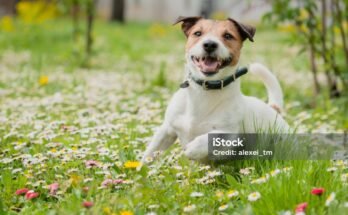Introduction:
When it comes to our animal friends, we always try to give them the best. From high-quality food to comfortable beds, every choice we make for them shows how much we love and care for them. A dog’s collar is one of the most important accessories because it not only helps with identification but also represents our relationship with our dog friends. Of all the options available, the blue dog collar is a timeless classic. In this in-depth guide, we will delve into the world of blue dog collars, learning about their types, history, significance, and how to select the ideal one for your furry friend.
Understanding the Significance of Dog Collars:

Dog collar history began thousands of years ago when humans first domesticated dogs for a variety of uses. At first, collars were used for practical purposes like confining and managing dogs when hunting or herding. Collars become status, affection, and ownership symbols over time. Dog collars are becoming more than just useful accessories; they are stylish pieces that express the individuality and sense of style of the dog and the owner.
Standard Collars:
- Purpose: Standard collars are the most popular kind and fulfill standard purposes including fastening leashes and retaining identifying tags.
- Significance: They highlight the responsibilities of taking care of and managing a dog, signifying the realistic aspects of pet ownership.
Collars for training (such as pinch, prong, or martingale collars):
- Function: Designed to help with training by giving the dog feedback when they make corrections or behavioral adjustments.
- Significance: Training collars stand for the dedication to compliance and appropriate behavior development, encouraging dialogue and mutual understanding between owner and dog.
Specialized collars (such as harnesses and head collars):
- Function: Alternative techniques of control, such as head collars and harnesses, are available for dogs who are prone to pulling or have respiratory problems.
- Significance: They stand for flexibility and take into account each dog’s particular requirements and level of comfort, putting their welfare first on walks and other activities.
Style Collars:
- Function: Fashion collars come in a variety of patterns, colors, and embellishments, with an emphasis mostly on aesthetics.
- Significance: Fashion collars allow dogs to express their individuality and match their owner’s sense of style, symbolizing the human yearning for self-expression and style.
Safety collars (e.g., reflective collars, breakaway collars):
- Function: Safety collars have characteristics like reflective strips or breakaway buckles to improve visibility in low light or prevent accidents.
- Significance: They emphasize how crucial it is to put dogs’ safety and well-being first, minimizing dangers and making sure they are protected in a variety of settings.
Electronic training collars, like bark collars, and other types of electronic collars:
- function: electronic collars use technology to provide signals or stimuli that change behavior, including stopping excessive barking or rewarding orders.
- Significance: Although contentious, electronic collars draw attention to the relationship between technology and pet care, igniting debates about moral issues and appropriate application in behavior modification and training.
Every style of dog collar has a unique meaning that reflects the many requirements, tastes, and ideals that dog owners have. The choice of collar symbolizes the special relationship and dedication between people and their canine friends, regardless of whether consideration is given to functionality, style, safety, or training.
The Timeless Appeal of Blue:

Among all the colors that can be utilized for dog collars, blue holds a special place in the hearts of many pet owners. Blue is a common color choice for collars because it conjures feelings of serenity, loyalty, and trust. Moreover, blue is a flexible and attractive color for dogs of all sizes since it goes well with a range of fur tones, from pure white to deep ebony.
Classic Blue Collars:
- Traditionally styled in solid blue, classic blue collars are composed of sturdy materials like leather or nylon and have a straightforward design.
- Appeal: Many dog owners who like a traditional and understated look for their pets are drawn to the timeless simplicity of classic blue collars. They are adaptable and appropriate for a range of situations, yet they also exude sophistication and elegance.
Designer Blue Collars:
- Described as follows: These high-quality collars are made with crystals, studs, or elaborate designs as ornaments.
- Appeal: Owners who value luxury and want their pets to stand out with a dash of glitz can purchase these collars. Designer blue collars are not just stylish accessories; they also represent the owner’s dedication to giving their pets the best care possible.
Reflective Blue Collars:
- Described as follows, reflective blue collars are made of materials or reflective strips that improve visibility in low light, such as on walks in the evening or outdoor excursions.
- Appeal: Reflective blue collars provide peace of mind by guaranteeing that their pets stay visible and safe regardless of the time of day or location. Safety is of the utmost importance to conscientious dog owners.
Adjustable Blue Collars:
- The mechanism of adjustable blue collars makes it simple to adjust the collar’s size to fit growing pups or dogs with different neck sizes.
- Allure: These collars are appealing to owners of growing pups or dogs whose sizes change since they offer an affordable and useful way to guarantee a snug and pleasant fit for their companion throughout all phases of its life.
Martingale Blue Collars:
- Described as having a loop that gradually tightens when tension is applied, martingale blue collars provide control without posing a choking hazard.
- Appeal: Martingale collars are a soft yet efficient form of management for dogs on walks or during training sessions. They are especially suitable for narrow-headed breeds like Greyhounds and Whippets. This useful design has a timeless beauty because of the classic blue color.
Blue dog collars have always been popular because of their class, usefulness, and adaptability. Dog owners can pick a style that fits their tastes while guaranteeing the safety, comfort, and style of their cherished pets, whether they choose a traditional, designer, reflective, adjustable, or martingale blue collar.
Types of Blue Dog Collars:



